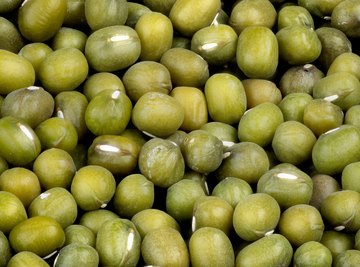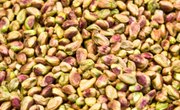
Mongo seeds are the familiar white bean sprouts seen in stores and restaurants. They're also known as mung beans, or mungbeans; their taxonomic name is Vigna radiata. They're easy to sprout in the classroom or home, and they illustrate the stages of germinating dicotyledonous seedlings -- dicots for short. Dicots sprout with separate leaves on a stem, unlike single-leaf monocots like grass. Mongos are also epigeal, meaning the seedlings emerge from their seed husks and leave them below ground.
Taking up Water
The first step is to soak the dry beans so they absorb water to begin the germination process. Any beans that float will not be viable. Given a day of soaking, the beans will swell as they take in water. Mung beans more than double their weight, and nearly triple their volume. While the water level in the container doesn't change, the swelling beans take up a greater proportion of the volume.
A Root Emerges
The seed husk, called the testa, swells more quickly than the embryonic seedling inside. The first sign of germination is the emergence of the white root tip called the radicle. Since this growth process requires oxygen, the beans are drained for exposure to air while sprouting. With each day, these roots grow longer. If the beans are sprouted in soil, there's nothing to see yet above the surface while this is happening.
Shedding the Seed Husk
The emergence of the radicle begins the splitting of the testa. Next the plumule -- the plant's first bud -- sheds the testa by growing out of it. This will become the above-ground part of the erect adult plant, beginning with the cotyledons -- the first set of simple, embryonic leaves. Mung beans exhibit epigeal germination, where the testa is left below the soil surface. The plumule is pushed upward by the growth of the radicle, which is also sprouting root hairs to gather moisture and nutrients from the soil.
True Leaves Develop
As the plumule breaks through the soil surface, the cotyledons at its end open to present the first two leaves, making the mung bean a dicot. These embryonic leaves have a simple oval shape, not like the adult plant's true leaves, which will grow later. They hold nutrients from the original seed, to feed the development of the first true leaves. As the leaves develop, the cotyledons wither, and the young plant has left its seedling stage.
References
About the Author
An ecological blogger, technical writer and trainer, Alex Silbajoris also leads a nonprofit watershed group. He is an avid gardener and cook. He holds a bachelor's degree in English and a master's degree in journalism, from The Ohio State University. Other studies include geology and biological sciences.
